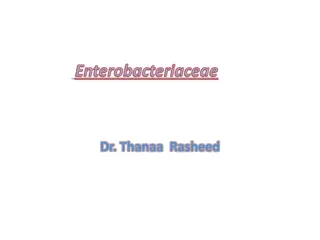Understanding Antigens and Immunogens: Types and Properties
Antigens are substances that stimulate the production of antibodies in the body, exhibiting specificity in immune reactions. They interact with immune response products like antibodies, BCRs, and TCRs. Immunogens induce detectable immune responses, leading to antibody production or T cell activation. Antigenicity allows substances to combine specifically with antibodies, whether they are immunogenic or not. Immunogens trigger an immune response and act as antigens. Different types of antigens exist based on their ability to induce an immune response or react with antibodies. Haptens are substances that can react with antibodies but require a carrier molecule to induce antibody formation.
Download Presentation

Please find below an Image/Link to download the presentation.
The content on the website is provided AS IS for your information and personal use only. It may not be sold, licensed, or shared on other websites without obtaining consent from the author. Download presentation by click this link. If you encounter any issues during the download, it is possible that the publisher has removed the file from their server.
E N D
Presentation Transcript
Unit: 2 - Fundamental of Immunology II Antigens : its types & properties An antigen is any substance which, when introduced parenterally into the body, stimulates the production of an antibody with which it reacts specifically and in observable manner. Specificity is the hallmark of all immuno- logical reactions. Antigen introduced into the body reacts only with those particular immunocytes (B or T lymphocytes) which carry the specific marker for that antigen and produce antibodies or cells complementary to that antigen.
Definations : Antigens : Molecules that interact specifically with the products of immune response generated by an immunogen, that is, with antibodies, B cell receptors (BCRs) and/or T cell receptors (TCRs). lmmunogen: A substance which induces a detectable immune response (humoral or cellular) . Immunogens stimulate the immune reaction, resulting in either the production of antibodies or the activation of T cells, and finally leading to either immune response or immune tolerance.
Antigenicity : The property that allows a substance to combine specifically with antibodies, whether or not they are immunogenic. An immunogen can trigger an immune response and act as an antigen in that immune response. Thus all immunogens are antigens but all antigens are not immunogens. Immunogenicity: The ability to induce humoral and/ or cell-mediated immune response.
Types of Antigens : The two attributes of antigenicity are : 1. Immunogenicity ( induction of an immune response) 2. Immunological reactivity ( specific reaction with antibodies or sensitised cell ) Based on the ability to carry out these two functions, antigens may be classified into different types. Complete antigen can induce antibody formation produce a specific and observable reaction with the antibody so produced.
Haptens : Heptens are substances that are incapable of inducing antibody formation by themselves but can react specifically with antibodies (in Greek, haptein means 'to fasten') . Haptens become immunogenic (capable of inducing antibodies) on combining with a larger molecule carrier. They may be complex or simple: complex haptens can precipitate with specific antibodies, Eg: capsular polysaccharide of Pneumococci simple haptens are non-precipitating.
Complex and simple haptens have bee described as polyvalent and univalent, respectively. it is assumed that precipitation requires the antigen to have two or more antibody combining sites. Epitope: The smallest unit of antigenicity is known as the antigenic determinant or epitope. The epitope is that small area on the antigen, usually consisting of four or five amino acids or monosaccharide residues, possessing a specific chemical structure, electrical charge and steric (spatial) configuration.
It is capable of sensitising an immunocyte and of reacting with its complementary site on the specific antibody or TCR. Epitopes may be present as a single linear segment of the primary sequence (sequential or linear epitope) (Fig.) or be formed by being brought together on surface residues from different sites of the peptide chain during its folding into the tertiary structure (conformational epitope) (Fig.)
Properties of Antigen : A number of properties that make a substance antigenic have been identified. 1. Size : Antigenicity is related to molecular size. Very large molecules, such as hemocyanins (MW 6.75 millions) are highly antigenic and particles with low molecular weight (less than 5000) are non-antigenic. 2. Chemical nature : Most naturally occurring antigens are proteins and polysaccharides. Lipids and nucleic acids are less antigenic. Their antigenicity is enhanced by combining with proteins.
- A certain degree of structural diversity is required for antigenicity. - All proteins are not antigenic e.g Gelatin which is nonimmunogenic because of its structural instability. 3. Susceptibility to tissue enzymes : Only substances which are metabolised and are susceptible to the action of tissue enzymes behave as antigens. Antigens introduced into the body are degraded by the host in to fragments of appropriate size containing the antigenic determinants.
- Phagocytosis and intracellular enzymes appear to play an essential role in breaking down antigens into immunogenic fragments. - Substances not susceptible to tissue enzymes, such as polystyrene latex, are not antigenic. Substances very rapidly broken down by tissue enzymes are also not antigenic. - Synthetic polypeptides, composed of D- amino acids are not antigenic, while polypeptides consisting of L-amino acids are antigenic.
4. Foreignness: Only antigens that are 'foreign'to the Individual, induce an immune response. - The antigenicity of a substance is related to the degree of its foreignness. Antigens from other individuals of the same species are less antigenic than those from other species. - Antigens from related species are less antigenic than those from distant species.
Antigenic Specificity : - The basis of antigenic specificity is stereochemical. - was first demonstrated by Obermayer and Pick and confirmed by Landsteiner. - antigenic specificity is determined by single chemical grouping and even by a single acid radical. - The position of the antigenic determinant group in the antigen molecule, attached at the ortho, meta or para positions shows differences in specificity. - The spatial configuration of the determinant group was also shown by differences in the antigenic specificity of the dextro, levo and meso isomers
- Antigenic specificity is not absolute. Cross- reactions can occur between antigens that bear stereochemical similarities. In some cases, apparent cross- reactions may be due to the sharing of identical antigenic determinants by different antigens. - The specificity of natural tissue antigens of animals may be considered under different categories as species, iso, auto and organ specificities. Species specificity: - Tissues of all individuals in a species contain species-specific antigens. There may be some degree of cross-reaction between antigens from related species.
- This immunological relationship is due to their phylogenetic relationship. - It has been used in tracing evolutionary relationships between species. - It has forensic applications in the identification of the species from blood and seminal stains. - Phylogenetic relationships reflecting cross- reactions between antigens from different species that cause hypersensitivity. Isospecificity: - Isoantigens are antigens found in some but not all members of a species. - A species may be grouped depending on the presence of different isoantigens in its members .
- The best examples of isoantigens are the human erythrocyte antigen , based on which individuals can be classified into different blood groups. - They are of clinical importance in bloodtransfusion and in isoimmunisation during pregnancy also help in determining disputed paternity cases. - Blood groups find application in anthropology. Autospecificity : - Autologous or self-antigens are ordinarily non-anti enic but there are exceptions. e.g Sequestrated antigens that are not normally found free in circulation or tissue fluids (such as the eye lens protein normally confined within its capsule) are not recognised as self-antigens.
Organ specificity: - Some organs, such as the brain, Kidneys and lens protein of different species, share the same antigen. Such antigens , found in different species are called organ-specific antigens. Heterogenetic (heterophile) specificity: - The same or closely related antigens may sometimes occur in different biological species, classes and kingdoms. These are known as heterogenetic or heterophile antigens. e.g Forssman antigen , a lipid carbohydrate complex widely distributed in many animals, birds, plants and bacteria.
- heterophile antigens are responsible for some diagnostic serological reactions in which antigens unrelated to etiological agents are employed (heterophile reaction): The Weil-Felix reaction in typhus fever The Paul-Bunnell test in infectious mononucleosis The cold agglutinin test in primary atypical pneumonia Biological Classification of Antigens : Depending on their ability to induce antibody formation,antigens are classified into: T cell-dependent (TD) antigens T cell-independent (Tl) antigens
T cell-dependent antigens: Most natural proteins are T-dependent antigens and B cells cannot respond to these antigens without a co- stimulatory signal from the TH cells. These antigens bind to the surface Ig on B cells and are internalised and processed to smaller peptides, which are then expressed on the surface of B cells complexed with MHCII and presented to T cells. Once these complexes are organised by TH cells, they secrete cytokines and start expressing the CD40 ligand which interacts with CD40 on the B cells. The T-B interaction and the cytokines provide the stimulus for B cell activation.
T cell-independent antigens: - Some antigens can directly stimulate antibody production by B cells, without the apparent participation of T cells. Such antigens are called TI antigens. - Most microbial sugars, lipids and certain nucleic acid are T cell-independent antigens. - These are of two types: Type 1 antigens (endotoxin, lipopolysaccharide [LPS]) are directly mitogenic for B cells and cause polyclonal B cell activation; Type 2 antigens - are polymeric compounds like polysaccharides (bacterial cell wall lipopolysaccharide or pneumococcal capsular polysaccharide) or proteins (flagellar proteins). They activate B cells to generate specific antibodies with the help of cytokines, and complement other cells like macrophages, dendritic cells, mast cells and NK cells.
Superantigens: - Superantigens are certain protein molecules, such as staphylococcal enterotoxins, that activate very large numbers of T cells irrespective of their antigenic specificity. - Superantigens bind outside the antibody binding groove directly to the lateral aspect of the TCR chain, while conventional antigen fragments bind to the heterodimer groove of the MHC molecules through the V regions of the TCR and chains (Fig.)
- Microbial superantigens are medium-sized proteins (MW 22-29 kDa) characterised by high resistance to proteases and to denaturation by CD4+ T cells. They cause the release of cytokines (IL-2) which results in massive proliferation of T- lymphocytes. This ultimately leads to further release of a variety of cytokines which can have profound effects on the immune system. - Some human diseases associated with superantigens are as follows :























